Papers by Mart Van de Kamp
European Journal of Biochemistry, 1992
Azurin*, a by-product of heterologous expression of the gene encoding the blue copper protein azu... more Azurin*, a by-product of heterologous expression of the gene encoding the blue copper protein azurin from Pseudomonas aeruginosa in Escherichia coli, was characterized by chemical analysis and electrospray ionization mass spectrometry, and its structure determined by X-ray crystallography. It was shown that azurin* is native azurin with its copper atom replaced by zinc in the metal binding site. Zinc is probably incorporated in the apo-protein after its expression and transport into the periplasm. Holo-azurin can be reconstituted from azurin* by prolonged exposure of the protein to high copper ion concentrations or unfolding of the protein and refolding in the presence of copper
Journal of Inorganic Biochemistry, 1991
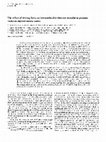
European Journal of Biochemistry, 1992
An intramolecular electron-transfer process has previously been shown to take place between the C... more An intramolecular electron-transfer process has previously been shown to take place between the Cys3 -Cys26 radical-ion (RSSR-) produced pulse radiolytically and the Cu(I1) ion in the blue singlecopper protein, azurin [Farver, 0. & Pecht, I. (1 989) Proc. Nut1 Acad. Sci. USA 86, further investigate the nature of this long-range electron transfcr (LRET) proceeding within the protein matnx, we have now investigated it in two azurins where amino acids have been substituted by single-site mutation of the wild-type Pseudomonas aeruginosa azurin. In one mutated protein, a methionine residue (Met44) that is proximal to the copper coordination sphere has been replaced by a positively charged lysyl residue ([M44K]azurin), while in the second mutant, another residue neighbouring the Cu-coordination site (His35) has been replaced by a glutamine ([H35Q]azurin). Though both these substitutions are not in the microenvironment separating the electron donor and acceptor, they were expected to affect the LRET rate because of their effect on the redox potential of thc copper sitc and thus on the driving force of the reaction, as well as on the reorganization energies of the copper site.
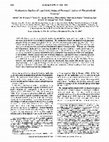
Biochemistry, 1995
Nisin is a cationic polycyclic bacteriocin secreted by some lactic acid bacteria. Nisin has previ... more Nisin is a cationic polycyclic bacteriocin secreted by some lactic acid bacteria. Nisin has previously been shown to permeabilize liposomes. The interaction of nisin was analyzed with liposomes prepared of the zwitterionic phosphatidylcholine (PC) and the anionic phosphatidylglycerol (PG). Nisin induces the release of 6-carboxyfluorescein and other small anionic fluorescent dyes from PC liposomes in a Apstimulated manner, and not that of neutral and cationic fluorescent dyes. This activity is blocked in PG liposomes. Nisin, however, efficiently dissipates the AI ) in cytochrome c oxidase proteoliposomes reconstituted with PG, with a threshold All, requirement of about -100 mV. Nisin associates with the anionic surface of PG liposomes and disturbs the lipid dynamics near the phospholipid polar head groupwater interface. Further studies with a novel cationic lantibiotic, epilancin K7, indicate that this molecule penetrates into the hydrophobic carbon region of the lipid bilayer upon the imposition of a A+. It is concluded that nisin acts as an anion-selective carrier in the absence of anionic phospholipids. In vivo, however, this activity is likely to be prevented by electrostatic interactions with anionic lipids of the target membrane. It is suggested that pore formation by cationic (type A) lantibiotics involves the local perturbation of the bilayer structure and a Apdependent reorientation of these molecules from a surfacebound into a membrane-inserted configuration.
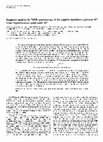
European Journal of Biochemistry, 1995
The amino acid sequence of the novel lantibiotic epilancin K7 from Staphylococcus epidermidis K7 ... more The amino acid sequence of the novel lantibiotic epilancin K7 from Staphylococcus epidermidis K7 was determined by NMR spectroscopy. NMR spectroscopy was used because sequencing by conventional Edman degradation techniques was prohibited by internal sequence blocks owing to the presence of modified residues. Epilancin K7 consists of 31 residues, including two a,P-didehydroalanine (one-letter code U) and two a$-didehydrobutyrine (0) residues, one lanthionine (A-S-A), two p-methyllanthionines (A*-S-A), and six lysines. Epilancin K7 has a molecular mass of 3032 5 1.5 Da. The amino acid sequence of epilancin K7 was derived from both through-space dipolar proton-proton interactions and throughbond scalar proton-carbon interactions as detected by two-dimensional 'H-NOESY, 'H-ROESY and threedimensional 'H-TOCSY-NOESY, and by two-dimensional 'H,'T-heteronuclear multiple-bond correlation spectroscopy, respectively. The sequence is as follows : r s i rshs7 XAUVLKOUIKVAKKYAKGVA*LA* AGANIOGGK.
Methods in Enzymology, 1993
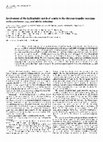
European Journal of Biochemistry, 1990
The electron-transfer reactions of site-specific mutants of the blue copper protein azurin from P... more The electron-transfer reactions of site-specific mutants of the blue copper protein azurin from Pseudomonas aeruginosa with its presumed physiological redox partners cytochrome c55 1 and nitrite reductase were investigated by temperature-jump and stopped-flow experiments. In the hydrophobic patch of azurin Met44 was replaced by Lys, and in the His35 patch His35 was replaced by Phe, Leu and Gln. Both patches were previously thought to be involved in electron transfer. 'H-NMR spectroscopy revealed only minor changes in the three-dimensional structure of the mutants compared to wild-type azurin. Observed changes in midpoint potentials could be attributed to electrostatic effects. The slow relaxation phase observed in temperature-jump experiments carried out on equilibrium mixtures of wild-type azurin and cytochrome c551 was definitively shown to be due to a conformational relaxation involving His35. Analysis of the kinetic data demonstrated the involvement of the hydrophobic but not the His35 patch of azurin in the electron transfer reactions with both cytochrome ~5 5 1 and nitrite reductase.
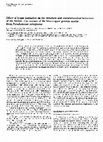
European Journal of Biochemistry, 1993
The structural and spectrochemical effects of the replacement of Met44 in the hydrophobic surface... more The structural and spectrochemical effects of the replacement of Met44 in the hydrophobic surface patch of azurin from Pseudomonas aeruginosa by a lysine residue were studied as a function of the ionization state of the lysine. In the pH range 5 -8, the optical absorption, resonance Raman, EPR and electron spin-echo envelope modulation spectroscopic properties of wild-type and Met44-+Lys (M44K) azurin are very similar, indicating that the Cu-site geometry has been maintained. At higher pH, the deprotonation of Lys44 in M44K azurin (pK, 9-10) is accompanied by changes in the optical-absorption maxima (614 nm and 450 nm instead of 625 nm and 470 nm) and in the EPR gll value (2.298 instead of 2.241), indicative of a change in the bonding interactions of Cu at high pH. The strong pH dependence of the electron self-exchange rate of M44K azurin supports the assignment of Lys44 as the ionizable group and demonstrates the importance of the hydrophobic patch for electron transfer. The pH dependence of the midpoint potentials of wild-type and M44K azurin can be accounted for by the ionizations of His35 and His83 and by the additional electrostatic effect of the mutation. Fax: +31 71 274537. Abbreviations. Ches, 2-(N-cyclohexylamino)ethmesulfonic acid; Cu(1) azurin, reduced azurin; Cu(I1) azurin, oxidized azurin; Em, midpoint potential ; ESE, electron self-exchange ; ESEEM, electron spin-echo envelope modulation; M44K, Met44+Lys ; RR, resonance Raman; wt, wild type; FT, Fourier transform. due His117 is located in the centre of this patch. The replacement of Met44 by the protonated lysine residue hardly affects the spectroscopic properties of the Cu site, but causes a considerable decrease of the k,,, value of azurin. At pH >8, deprotonation of Lys44 produces a new type-] Cu site, whereas the magnitude of the k,,, value of the protein is largely restored. At pH 5 and pH 8, the midpoint potential, Em, of Met44+Lys (M44K) azurin is higher than the wildtype (wt) azurin Em by 60 mV. At pH > 8, deprotonation of Lys44 in M44K azurin reduces the En, difference from 60 mV to 40 mV. The pH dependence of the wt and M44K azurin En, values is analyzed in terms of the titration of His35, His83 and Lys44. In addition, the effects of the M44K mutation and the Cu-ion oxidation state (I or TI) on the pK, values of the titratable His35 and His83 of azurin are reported and analyzed. The structural and functional implications of the findings are discussed.

European Journal of Biochemistry, 2008
The amino acid sequence of the novel lantibiotic epilancin K7 from Staphylococcus epidermidis K7 ... more The amino acid sequence of the novel lantibiotic epilancin K7 from Staphylococcus epidermidis K7 was determined by NMR spectroscopy. NMR spectroscopy was used because sequencing by conventional Edman degradation techniques was prohibited by internal sequence blocks owing to the presence of modified residues. Epilancin K7 consists of 31 residues, including two α,β-didehydroalanine (one-letter code U) and two α, β-didehydrobutyrine (O) residues, one lanthionine (A-S-A), two β-methyllanthionines (A*-S-A), and six lysines. Epilancin K7 has a molecular mass of 3032 ± 1.5 Da. The amino acid sequence of epilancin K7 was derived from both through-space dipolar proton-proton interactions and through-bond scalar proton-carbon interactions as detected by two-dimensional 1H-NOESY, 1H-ROESY and three-dimensional 1-TOCSY-NOESY, and by two-dimensional 1H,13Cheteronuclear multiple-bond correlation spectroscopy, respectively. The sequence is as follows: The N-terminal residue X partly resembles an alanine but its exact nature is unclear. The organization of the sulfide-bridge-containing (β-methyl-) lanthionines was revealed by 1H-NMR and 1H,13C-NMR spectroscopy. Epilancin K7 has a linear structure and a high positive net charge, and therefore is classified as a type-A lantibiotic. NMR analysis of a degraded though still active form of epilancin K7 showed that two N-terminal residues of epilancin K7 were missing, owing to decomposition at the α,β-didehydro alanine at position 3; it was called the epilancin K7-(3–31)-peptide (peptide fragment of epilancin K7 consisting of positions 3–31). The usefulness of three-dimensional 1H-TOCSY-NOESY, and two-dimensional 1H,13C-heteronuclear multiple-bond correlation spectroscopy at natural abundance for the study of (modified) polypeptides is demonstrated.
Applied and Environmental Microbiology, 2000
Penicillium chrysogenum uses sulfate as a source of sulfur for the biosynthesis of penicillin. Su... more Penicillium chrysogenum uses sulfate as a source of sulfur for the biosynthesis of penicillin. Sulfate uptake and the mRNA levels of the sulfate transporter-encoding sutB and sutA genes are all reduced by high sulfate concentrations and are elevated by sulfate starvation. In a high-penicillin-yielding strain, sutB is effectively transcribed even in the presence of excess sulfate. This deregulation may facilitate the efficient incorporation of sulfur into cysteine and penicillin.
In industrial fermentations, Penicillium chrysogenum uses sulfate as the source of sulfur for the... more In industrial fermentations, Penicillium chrysogenum uses sulfate as the source of sulfur for the biosynthesis of penicillin. By a PCR-based approach, two genes, sutA and sutB, whose encoded products belong to the SulP superfamily of sulfate permeases were isolated. Transformation of a sulfate uptake-negative sB3 mutant of Aspergillus nidulans with the sutB gene completely restored sulfate uptake activity. The sutA gene did not complement the A. nidulans sB3 mutation, even when expressed under control of the sutB promoter. Expression of both sutA and sutB in P. chrysogenum is induced by growth under sulfur starvation conditions. However, sutA is expressed to a much lower level than is sutB. Disruption of sutB resulted in a loss of sulfate uptake ability. Overall, the results show that SutB is the major sulfate permease involved in sulfate uptake by P. chrysogenum.
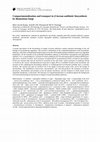
Antonie Van Leeuwenhoek International Journal of General and Molecular Microbiology, 1999
A proper description of the biosynthesis of fungal β-lactam antibiotics requires detailed knowled... more A proper description of the biosynthesis of fungal β-lactam antibiotics requires detailed knowledge of the cell biology of the producing organisms. This involves a delineation of the compartmentalization of the biosynthetic pathways, and of the consequential transport steps across the cell-boundary plasma membrane and across organellar membranes. Of the enzymes of the penicillin biosynthetic pathway in Penicillium chrysogenum and Aspergillus nidulans, δ-(L-α-aminoadipyl)-L-cysteinyl-D-valine synthetase (ACVS) and isopenicillin N synthase (IPNS) probably have a cytosolic location. Acyl-coenzyme A:isopenicillin N acyltransferase (IAT) is located in microbodies. Of the two enzymes that may be involved in activation of the side chain, acetyl-coenzyme A synthetase (ACS) is located in the cytosol, and phenylacetyl-coenzyme A ligase (PCL) is probably located in the microbody. All enzymes of the cephalosporin biosynthesis pathway in Cephalosporium acremonium probably have a cytosolic location. The vacuole may play an ancillary role in the supply of precursor amino acids, and in the storage of intermediates. The distribution of precursors, intermediates, end- and side-products, the transport of nutrients, precursors, intermediates and products across the plasma membrane, and the transport of small solutes across organellar membranes, is discussed. The relevance of compartmentalization is considered against the background of recent biotechnological innovations of fungal β-lactam biosynthesis pathways.
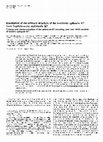
European Journal of Biochemistry, 1995
Lantibiotics are bacteriocins that contain unusual amino acids such as lanthionines and a$-didehy... more Lantibiotics are bacteriocins that contain unusual amino acids such as lanthionines and a$-didehydro residues generated by posttranslational modification of a ribosomally synthesized precursor protein. The structural gene encoding the novel lantibiotic epilancin K7 from Staphylococcus epidemzidis K7 was cloned and its nucleotide sequence was determined. The gene, which was named elkA, codes for a 55residue preprotein, consisting of an N-terminal 24-residue leader peptide, and a C-terminal 31 -residue propeptide which is posttranslationally modified and processed to yield mature epilancin K7. In common with the type-A lantibiotics nisin A and nisin Z , subtilin, epidermin, gallidermin and Peps, pre-epilancin K7 has a so-called class-A1 leader peptide. Downstream and upstream of the elk4 gene, the starts of two open-reading-frames, named elkP and elkT, were identified. The elkP and elkT genes presumably encode a leader peptidase and a translocator protein, respectively, which may be involved in the processing and export of epilancin K7. The amino acid sequence of the unmodified pro-epilancin K7, deduced from the elkA gene sequence, is in full agreement with the amino acid sequence of mature epilancin K7, determined previously by means of NMR spectroscopy [van de Kamp, M., Horstink, L. M., van den Hooven, M. W., . The first residue of mature epilancin K7 appears to be modified in a way that has not been described for any other lantibiotic so far. NMR experiments show that the elkA-encoded serine residue at position + I of pro-epilancin K7 is modified to a 2-hydroxypropionyl residue in the mature protein.
Journal of The American Chemical Society, 1990
Details of the crystal structure determination and tables of fractional coordinates and isotropic... more Details of the crystal structure determination and tables of fractional coordinates and isotropic or equivalent isotropic thermal parameters, anisotropic thermal parameters for non-hydrogen atoms, bond lengths and angles, and torsional angles (non-hydrogens) for 4 (15 pages); ...
Journal of The American Chemical Society, 1991
Low molecular weight copper complexes are often used as model compounds to study the coordination... more Low molecular weight copper complexes are often used as model compounds to study the coordination of Cu ions in proteins.

European Journal of Biochemistry, 1996
The interaction of nisin, a membrane-interacting cationic polypeptide, with membrane-mimicking mi... more The interaction of nisin, a membrane-interacting cationic polypeptide, with membrane-mimicking micelles of zwitterionic dodecylphosphocholine and of anionic sodium dodecylsulphate was studied. Direct contacts have been established through the observation of NOEs between nisin and micelle protons. Spin-labeled DOXYL-stearic acids were incorporated into the two micellar systems. From the paramagnetic broadening effects induced in the 1H-NMR spectrum of nisin it is concluded that the molecule is localized at the surface of the micelles. The interactions of nisin with zwitterionic and with anionic micelles resemble each other as do the nisin conformations [van den Hooven, H. W., Doeland, C. C. M., van de Kamp, M., Konings, R. N. H., Hilbers, C. W. & van de Ven, F. J. M. (1995) Eur J. Biochem. 235, 382-393]. The hydrophobic residues are immersed into the micelles and oriented towards the center, whereas the more polar or charged residues have an outward orientation. The micellar systems are considered to model the first step in the mechanism of antimicrobial action of nisin, this step is the binding of nisin to the cytoplasmic membrane of target bacteria. Detailed information on this initial binding step is obtained. Hydrophobic and electrostatic interactions appear to be involved in the nisin-micelle contacts. It is suggested that subtilin, a lantibiotic structurally related to nisin, has a comparable membrane interaction surface.
Fungal Genetics and Biology, 2002
Penicillin biosynthesis by Penicillium chrysogenum is a compartmentalized process. The first cata... more Penicillin biosynthesis by Penicillium chrysogenum is a compartmentalized process. The first catalytic step is mediated by d-(L-aaminoadipyl)-L-cysteinyl-D-valine synthetase (ACV synthetase), a high molecular mass enzyme that condenses the amino acids L -aaminoadipate, L -cysteine, and L -valine into the tripeptide ACV. ACV synthetase has previously been localized to the vacuole where it is thought to utilize amino acids from the vacuolar pools. We localized ACV synthetase by subcellular fractionation and immunoelectron microscopy under conditions that prevented proteolysis and found it to co-localize with isopenicillin N synthetase in the cytosol, while acyltransferase localizes in microbodies. These data imply that the key enzymatic steps in penicillin biosynthesis are confined to only two compartments, i.e., the cytosol and microbody. Ó
Biometals, 1990
Biological electron transfer is not well understood. The question is addressed in this contributi... more Biological electron transfer is not well understood. The question is addressed in this contribution with reference to the so-called blue copper proteins, each of which has a single copper atom at its active centre. The redox activity (as probed by the electron self exchange reaction) of the Cu centre seems not to be affected. The electron self exchange reaction is known to proceed through His-117, and the hydrophobic patch is most important in the formation of the azurin/azurin encounter complex. Ph effects have not been observed on the three-dimensional structure ofA. denitrificans azurin, which may indicate that if present at all these have no direct physiological implications. Mutants are in process of construction.

Antonie Van Leeuwenhoek International Journal of General and Molecular Microbiology, 1996
Lantibiotics are antibiotic peptides that contain the rare thioether amino acids lanthionine and/... more Lantibiotics are antibiotic peptides that contain the rare thioether amino acids lanthionine and/or methyllanthionine. Epidermin, Pep5 and epilancin K7 are produced by Staphylococcus epidermidis whereas gallidermin (6L-epidermin) was isolated from the closely related species Staphylococcus gallinarum. The biosynthesis of all four lantibiotics proceeds from structural genes which code for prepeptides that are enzymatically modified to give the mature peptides. The genes involved in biosynthesis, processing, export etc. are found in gene clusters adjacent to the structural genes and code for transporters, immunity functions, regulatory proteins and the modification enzymes LanB, LanC and LanD, which catalyze the biosynthesis of the rare amino acids. LanB and LanC are responsible for the dehydration of the serine and threonine residues to give dehydroalanine and dehydrobutyrine and subsequent addition of cysteine SH-groups to the dehydro amino acids which results in the thioether rings. EpiD, the only LanD enzyme known so far, catalyzes the oxidative decarboxylation of the C-terminal cysteine of epidermin which gives the C-terminal S-aminovinylcysteine after addition of a dehydroalanine residue.
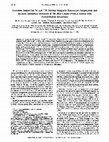
Biochemistry, 1992
Complete sequential lH and lSN resonance assignments for the reduced Cu(1) form of the blue coppe... more Complete sequential lH and lSN resonance assignments for the reduced Cu(1) form of the blue copper protein azurin (M, 14 000,128 residues) from Pseudomonas ueruginosa have been obtained at pH 5.5 and 40 OC by using homo-and heteronuclear two-dimensional (2D) and three-dimensional (3D) nuclear magnetic resonance spectroscopic experiments. Combined analysis of a 3D homonuclear 'H Hartmann-Hahn nuclear Overhauser (3D lH HOHAHA-NOESY) spectrum and a 3D heteronuclear 'H nuclear Overhauser lH(lSNj single-quantum coherence (3D lH{lSNj NOESY-HSQC) spectrum proved especially useful. The latter spectrum was recorded without irradiation of the water signal and provided for differential main chain amide (NH) exchange rates. N M R data were used to determine the secondary structure of azurin in solution. Comparison with the secondary structure of azurin obtained from X-ray analysis shows a virtually complete resemblance; the two @-sheets and a 310-a-310 helix are preserved a t 40 OC, and most loops contain well-defined turns. Special findings are the unexpectedly slow exchange of the Asn-47 and Phe-114 NH's and the observation of His-46 and His-117 Ne2H resonances. The implications of these observations for the assignment of azurin resonance Raman spectra, the rigidity of the blue copper site, and the electron transfer mechanism of azurin are discussed. Nd2H 7.73, 7.14 (114.3) CT2H 7 0.99 Nd2Hj.60, 6.95 (1 10.4) CY2H3 0.81; C'IH 1.48,0.93; C*'H3 0.25
Uploads
Papers by Mart Van de Kamp